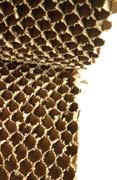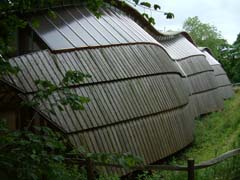This category contains my answers to a series of questions that often come up when I’m talking to groups about sustainable design and the ideas in my book, The Designers Atlas of Sustainability.
Q: what do you think are some of the best examples of sustainable design around today?
A: I think there are a lot of interesting examples out there, some that are working well and some that perhaps failed but still offer good lessons. The purpose of the Atlas has not been to declare which examples are best, but rather to provide some framework for thinking about what makes a given example sustainable or not, on ecological, economic or cultural grounds. A design solution may hit the right cultural notes while overlooking significant ecological issues. For example, a packaging design might drastically improve accessibility for elderly or otherwise impaired users, while at the same time perform poorly in ecological terms.
by what criteria are they “sustainable”?


As I mention in another answer, sustainability is also very context specific. Something that we would see as “sustainable” for a tropical city may not look so sustainable in a nordic one, for example. This sensitivity to context is another factor that makes me hesitant to promote generalized “good examples.”
On the other hand, there are times when you just need a specific example (or many) to communicate the ideas. After all, visualizing new solutions, exploring alternative futures in three dimensions — this is the power of design. But new examples are appearing all the time and few people can track all of them. The real question here is: how do you find good examples when you need them? I tend to use a few different approaches.
For architecture I typically turn to one of the organizations that work on highlighting good examples. For instance, there are several systems now that rate building sustainability. Buildings rated “platinum” by LEED (in the US) or “excellent” by BREEAM (in the UK) are generally good examples, although even these systems and their results have some critics. Similarly the American Institute of Architects (AIA) has an annual award for “green design” that highlights good examples. Some progressive and well respected newspapers that cover architectural design will produce annual top-ten green architecture lists (for example The Guardian newspaper in England). These are some places to start your search.
There are fewer systematic ratings or awards for sustainable product design. Although MBDC has released the “Cradle to Cradle” rating system, at this stage its scope is limited. Products are also challenging because they change so often. A good design this year may go out of production next year in favor of a new model. When I need to find examples of sustainable product design I use several different strategies, as I outline below.
Certification systems and standards
There are a number of third party systems for certifying products and materials. For example, sustainably harvested wood is certified by the Forest Stewardship Council, which develops a chain of custody for certified wood. Energy efficient appliance can earn an “energy star” rating or exceed appliance energy efficiency standards. Other systems deal with fair trade, recycled content material, organic material and so forth. Sometimes looking into these standards will yield good examples, or particularly aggressive efforts along one of these lines.
Individual activists and nonprofit groups
Typically there are individual design activists, such as William McDonough and Michael Braungart or Amory and Hunter Lovins, that are known for their pioneering work in greening products and buildings. Kate Fletcher is an expert on sustainable fashion and textiles. It’s worth checking to see what they and others like them are up to–recent projects, writings and what they think are good examples. Nonprofit environmental groups also get involved in products or materials. For example Greenpeace has looked at PVC-free products and materials and other chemical concerns. The group Greenblue has various product-related initiatives. The group Fashioning an Ethical Industry works on ethics in the fashion industry. And there are others; Design Feast offers a good webliography on sustainable and activist design. I also list a range of groups and centers working on sustaianble design here.
Companies
There are companies that have a reputation for pursuing sustainable design more aggressively than usual. We hope this roster is growing all the time. At the moment I’m aware of some interesting work going on within companies such as Wilkahn (Germany), Nike, Nokia, Patagonia, IKEA, and Philips. I’m sure there are many more and as you get into the field you may become more aware of the industry leaders relevant to your work. I rarely start at the company’s corporate web pages. I typically start with an internet search on google (or increasingly dogpile.com) using as search terms the company or product name + “sustainable design” (or “recycled material”, “reuse” or “sustainable product” etc.). This search approach will sometimes turn up critiques and articles about companies and their work.
In summary, these are a few of the methods I use to find good examples. What methods do you use? What activists would you add to the list I’ve given? It’s important to ask around, keep checking to update your examples and also to do your own analysis on how “sustainable” any given building or product is.
Thomas Friedman is my favorite promoter of all things sustainable. He is one of the few people that can tie together green, terrorism, and energy independence in a way that ordinary people can understand. Folks like him will be the ones who get “green” to move from a niche market to a truly everyday standard.
Chris
LEED AP
http://www.everblueenergy.com/